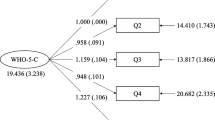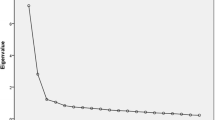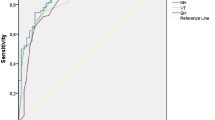Abstract
A simple tool consisting of two questions for screening depressive symptoms has been shown to be useful in primary care settings, but its validity in patients with diabetes has yet to be evaluated. We compared the test performance of this two-question instrument with that of WHO (The World Health Organization)-5. We consecutively enrolled 153 patients with type 2 diabetes who visited a diabetes clinic in Japan. Using the Center for Epidemiologic Studies Depression Scale as a reference standard of depressive symptoms, we calculated the sensitivity and specificity of the two-question instrument and WHO-5, and compared the area under the ROC curves of these tests. The two-question instrument had a sensitivity of 53.6% (95% CI, 39.7–67.0%) and specificity of 67.7% (95% CI, 58.1–74.9%). With the conventional cutoff point equal to or less than 13 points, the WHO-5 had a sensitivity of 57.1% (95% CI, 43.2–70.3%) and specificity of 82.5% (95% CI, 81.9–94.9%). The area under the ROC curve for the WHO-5 and two-item questionnaire, an indicator of discriminatory power, was 0.81 and 0.73, respectively, showing a statistically significant difference (P = 0.0453). The two-question instrument had statistically lower discriminatory power than the WHO-5 in screening depressive symptoms in patients with diabetes. We do not recommend the use of the two-question instrument for screening depressive symptoms in patients with diabetes.

Similar content being viewed by others
References
Anderson RJ, Freedland KE, Clouse RE, Lustman PJ (2001) The prevalence of comorbid depression in adults with diabetes: a meta-analysis. Diabetes Care 24:1069–1078
Golden SH, Lazo M, Carnethon M et al (2008) Examining a bidirectional association between depressive symptoms and diabetes. JAMA 299:2751–2759
Lustman PJ, Griffith LS, Clouse RE (1997) Depression in adults with diabetes. Semin Clin Neuropsychiatry 2:15–23
Lustman PJ, Harper GW (1987) Nonpsychiatric physicians’ identification and treatment of depression in patients with diabetes. Compr Psychiatry 28:22–27
American Diabetes Association (2009) Executive summary: standards of medical care in diabetes—2009. Diabetes Care 32(suppl 1):S6–S12
Zung WW (1965) A self-rating depression scale. Arch Gen Psychiatry 12:63–70
Beck AT, Ward CH, Mendelson M, Mock J, Erbaugh J (1961) An inventory for measuring depression. Arch Gen Psychiatry 4:561–571
Radloff LS (1977) The CES-D scale: a self report depression scale for research in the general population. Appl Psychol Meas 1:385–401
Bech P, Gudex C, Johansen KS (1996) The WHO (Ten) Well-Being Index: validation in diabetes. Psychother Psychosom 65:183–190
Bech P, Olsen LR, Kjoller M, Rasmussen NK (2003) Measuring well-being rather than the absence of distress symptoms: a comparison of the SF-36 Mental Health subscale and the WHO-Five Well-Being Scale. Int J Methods Psychiatr Res 12:85–91
de Wit M, Pouwer F, Gemke RJ, Delemarre-van de Waal HA, Snoek FJ (2007) Validation of the WHO-5 Well-Being Index in adolescents with type 1 diabetes. Diabetes Care 30:2003–2006
Spitzer RL, Williams JB, Kroenke K et al (1994) Utility of a new procedure for diagnosing mental disorders in primary care. The PRIME-MD 1000 study. JAMA 272:1749–1756
Awata S, Bech P, Yoshida S et al (2007) Reliability and validity of the Japanese version of the World Health Organization-Five Well-Being Index in the context of detecting depression in diabetic patients. Psychiatry Clin Neurosci 61:112–119
Lowe B, Spitzer RL, Grafe K et al (2004) Comparative validity of three screening questionnaires for DSM-IV depressive disorders and physicians’ diagnoses. J Affect Disord 78:131–140
Whooley MA, Avins AL, Miranda J, Browner WS (1997) Case-finding instruments for depression. Two questions are as good as many. J Gen Intern Med 12:439–445
Hanley JA, McNeil BJ (1983) A method of comparing the areas under receiver operating characteristic curves derived from the same cases. Radiology 148:839–843
DeLong ER, DeLong DM, Clarke-Pearson DL (1988) Comparing the areas under two or more correlated receiver operating characteristic curves: a nonparametric approach. Biometrics 44:837–845
Arroll B, Khin N, Kerse N (2003) Screening for depression in primary care with two verbally asked questions: cross sectional study. BMJ 327:1144–1146
Kroenke K, Spitzer RL, Williams JB (2001) The PHQ-9: validity of a brief depression severity measure. J Gen Intern Med 16:606–613
Fukuhara S, Green J, Albert J et al (2006) Symptoms of depression, prescription of benzodiazepines, and the risk of death in hemodialysis patients in Japan. Kidney Int 70:1866–1872
Jones LE, Doebbeling CC (2007) Depression screening disparities among veterans with diabetes compared with the general veteran population. Diabetes Care 30:2216–2221
Acknowledgments
This work was supported in part by a Grant-in-Aid for Scientific Research (30238505) from the Ministry of Education, Science, Sports and Culture, Japan.
Conflict of interest
Nothing to declare.
Author information
Authors and Affiliations
Corresponding author
Rights and permissions
About this article
Cite this article
Furuya, M., Hayashino, Y., Tsujii, S. et al. Comparative validity of the WHO-5 Well-Being Index and two-question instrument for screening depressive symptoms in patients with type 2 diabetes. Acta Diabetol 50, 117–121 (2013). https://doi.org/10.1007/s00592-010-0219-z
Received:
Accepted:
Published:
Issue Date:
DOI: https://doi.org/10.1007/s00592-010-0219-z




